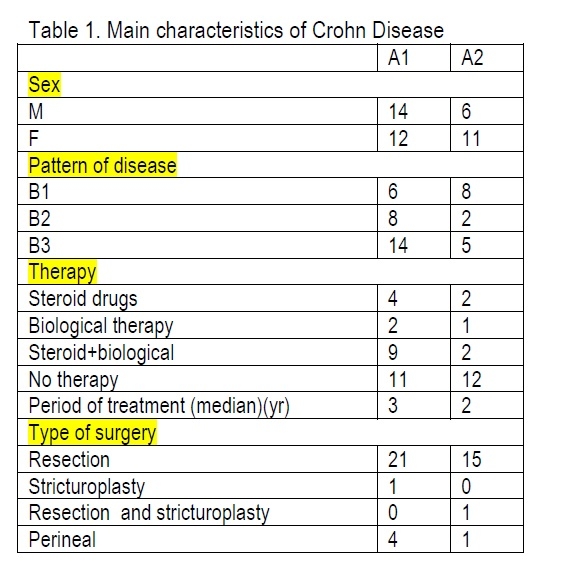SURGICAL TREATMENT OF CROHN'S DISEASE AMONG A2 PATIENTS IN THE BIOLOGICAL ERA: A SINGLE TERTIARY REFERRAL CENTER EXPERIENCE IN NORTHEN ITALY
Gabriela Nita*1, Rocco Scalzone1, Fabrizio Aguzzoli2, Alessandra Soriano3, Alberto Colognesi2, Marina Beltrami3, Claudio Pedrazzoli2
1General Surgery Department, Ospedale Sant'Anna, Castelnovo ne' Monti, Reggio Emilia, Italy; 2Oncological Surgery Unit, IRCCS Arcispedale Santa Maria Nuova, Azienda Unità Sanitaria Locale-IRCCS di Reggio Emilia, Reggio Emilia, Italy, Italy; 3Internal Medicine Unit, IRCCS Arcispedale Santa Maria Nuova, Azienda Unità Sanitaria Locale-IRCCS di Reggio Emilia, Reggio Emilia, Italy, Italy
Introduction:
Surgical treatment of Crohn's disease (CD) represents a useful tool since relapses and disease are still challenging even in the era of targeted therapies.
Materials and methods:
Data coming from surgically treated patients (pts) during the period 2013-2018 were retrospectively included in a CD tertiary referral centre in Northern Italy. The database included demographical features, medical history prior to surgery, type of procedure and follow-up. Therapeutic flow-chart was discussed among a monthly multidisciplinary meeting according to international guidelines available.
Results:
43 pts were included and main characteristics are summarised in table 1. Median age at surgery was 48 years (range 22-79), 39% of pts A2 and the median age of onset was 35 year-old. Among the whole surgical population 36 resections, 1 stricturoplasty and 1 combination of resections and stricturoplasties were performed. The subset of surgically treated A2 pts (n = 17) were reviewed according to prior medical treatment: 2 pts received steroid drugs, 1 pts a biological treatment, 2 a combination of both and 12 pts were not medically treated before surgery. There were 5 emergency procedures, with 1 pts of failure pf percutaneous drainage, and 38 delayed interventions, with 1 percutaneuos procedure previously. The laparoscopic approach was possible in 2 cases. Median duration of treatment before surgery was 2 years (0-12 years).
Discussion:
Clinical course of CD, even in the era of targeted therapies, remains still challenging. A longer history of disease, an older age of onset and cases refractory to medical treatment in the present series may represent an interesting subset in which surgery could be a useful option.
Conclusion:
In patients with advanced age and CD refractory to medical treatment, surgery represents still a good therapeutic option even in the modern era.
Back to 2019 Posters




